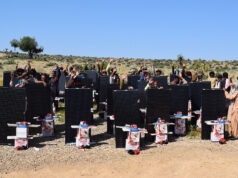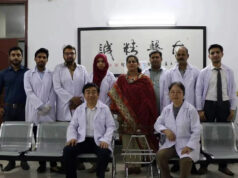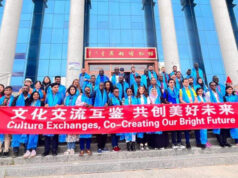Dervaish Ali
George Orwell, the famous author of the dystopian novel Nineteen Eighty-Four and of the brilliant satire on totalitarianism The Animal Farm once wrote, “He who controls the past controls the future. He who controls the present controls the past”. Thinking about the future is a fundamental human characteristic. Strange as it may seem, future, like history, is important for understanding the present of societies. Like history, it is also about memory and consciousness. In other words, just like our sense of the present is informed by our pasts, we are also creatures of future. Future awareness can have an orientating role, to make a people aware where they are now, what changes are likely to occur, how these rapid changes will be influenced by them and vice versa and where they want to go.
Why is thinking about future important? In many areas of social and behavioral sciences it has been shown that our future images influence our behavior in the present. Just observe how the present of a person changes as soon as he or she is diagnosed with a terminal cancer! On the contrary, marvel at the sparkle in the eyes of a five year old on Christmas Eve, or on the last evening of the holy month of Ramzan just after he or she hears the loud cries of moon hunters confirming the sighting of the new moon of Shawwal. Our expectations, hopes and fears strongly influence our present behavior.
In the interdisciplinary social sciences, a strategic and interesting field of scholarship is that of Futures Studies. Futures Studies is not a proper discipline in the strict academic sense of the term but has produced and developed a diverse and substantial knowledge base with its own sophisticated journals, monographs and expert scholars and practitioners with diverse cultural and professional backgrounds. It is a mode of inquiry which draws insights from a wide range of other disciplines and sources of knowledge. Futures (always in plural) scholars study or look into the future using different methodologies or techniques, from purely quantitative or descriptive to qualitative or prescriptive/normative ones. There is forecasting, statistical trend analysis, simulation or computer modeling or extrapolation, scenario construction and so on.
According to some early scholars in this field, the different ways of looking into the future can be categorized as follows: by social extrapolation from the past and present into the future; by studying historical and fundamental elements of social change, which implies a careful historical analysis, in order to identify the dominant trends; by choices, as parts of specific frames of references, from which trends are projected into the future (Daniel Bell 1973).
Although the future cannot be known and predicted with certainty, scenarios and images of future can inform and encourage wise thinking and action. Rational and systematic speculation about future is important because tomorrow is very much the object of our decisions and actions taken today. While a hypothetical future can be a source of hope and inspiration for constructive action and the creation of new knowledge for the betterment of a community and nation, it can also serve sinister and destructive present ends and ambitions, as those of demagogues, for example. But equally detrimental can be a future-blind present mindedness that fails to take into account long-term consequences of actions. Future mindedness and awareness about the future respond to a need that is especially felt in times of crisis, a period of rapid and complex change. Also, an obvious reason to study futures or future alternatives is to be able to create a better context for the decision making process in the present and to influence and shape outcomes that are desirable.
Scenario analysis is an important and a popular way of looking at the future. Scenarios are the most creative and flexible futures studies tools that capture the different aspects of natural and social reality through insights drawn from different domains of knowledge and have a wide range of applications. Experts who study socio-economic, political and cultural trends tell us that scenarios are basically stories, future narratives about what might or could possibly/potentially happen under certain circumstances, if current trends continue, for example, or if some specific course of alternative actions is taken.
The future of Balochistan and its people can also be envisioned in terms of scenarios, some of which I will try to outline here. These scenarios will have to be developed further in order to get some sense of the nature and complexity of the issues involved and the full implication of their materialization, or otherwise, on the province’s communities in the coming years. A thorough study of all these need to be made in order to reach a better understanding of the situation. The purpose of this post is not that. At best, it is reflective/speculative as far as the understanding of the situation is concerned, and suggestive in the way of pointing towards possible remedial measures.
Scenario 1: The status quo prevails.
Under this scenario, nothing, or not much will change. Things will remain the same, as they are and have been for a long time for the people of the province—-much like those ICU patients who are on life-support systems, half dead and half alive. Although it is true that most things in Pakistan can be talked about in such terms, Balochistan remains a special case of neglect, exploitation and even abuse. The many vested interests, local as well as non-local (external to the province) and international, all the traditional beneficiaries of the cruel “system”, will continue with their sordid ways. The French Marxist-turned-Muslim philosopher Roger Garaudy once described the Center-Periphery relationship between the West and the non-West as that of “the sick and the deceived”. That imagery is useful for us to see the plight of Balochistan as the perennially neglected orphan, the step-child periphery!
In a sense, the province has been a classic case of the old colonial system of divide and rule or a laboratory for the ugly politics of carrot and stick. In the 1970s when NAP (National Awami Party) was in power, it was the Bugtis vs. the Marris, the Raisanis vs. the Rinds and sometimes the big nawabs and sardars against the progressive and enlightened “half sardars” like Ghaus Bakhsh Bizenjo, a man I consider one of the greatest political visionaries the province has ever produced. In the 1980s and 1990s this scummy divisive game took a wicked turn and was transformed into a deadly ethno-sectarian strife that has not only devastated certain communities in the province but has also corrupted the traditional local cultures of harmonious and peaceful co-existence. With no apologies to those readers who incessantly and uncritically sing the song, and dance to the beat, of “naya” Pakistan, I say that we are still witnessing the same phenomenon in this peripheral and forgotten province, although in much sophisticated and subtler forms. It’s just that the powers-that-be have become more invisible and, thanks to the postmodernists, we know that power is at its most effective when it hides itself! For obvious reasons (clear to the perceptive readers, at least) therefore, let’s call this scenario Sanjrani-ism!
Scenario 2: The future is in the past
Here, the ruling elite and the people of the province will collectively say “enough!” That is what the Spanish basta! means in English. As the logical counter of scenario 1 and its undesirable outcomes, this scenario is all about getting fed up with the unjust status quo and, therefore, about setting things right for the province. For starters, the nefarious game of political musical chairs that pits the intellectually myopic and opportunist local satraps against each other to the detriment of the common people—-and these self-seekers come from all the communities in the province—-will have to stop under this scenario. Given the instrumental, cost-benefit nature of modern politics everywhere, there will still be self-interest and opportunism, for sure, but there will also be an over-arching vision and concern for Balochistan that will not sacrifice the bigger, longer-term interests of the province for short term personal gains.
How will this happen, one is tempted to ask. With an awakening of social and political awareness in the people, partly through informational and educational networks of like-minded citizenry and political activist groups—locally, nationally and globally—-and partly through the guidance and leadership of self-respecting leaders (and there are still many of them around) using local grassroots organizations and civil society institutions, a culture of democratic accountability may well take root. What this will mean is that people, once empowered and armed with the necessary awareness and knowledge-based tools, will hold their representatives accountable for what they do with the mandate they are given. In other words, democracy, once nativized, meaning a real-life, grounded and practical version of it reflecting and responding to the hopes and aspirations of the natives, will finally become functional. It will begin to respond to the cries of the masses. It will be made to serve, and meet the needs of, the local constituents rather than worshipped as some high-minded ideal that never materializes into real benefits for the common people. Across the country, there is already a discernible trend of people insisting on real, legitimate payback for their votes; they want delivery from those whom they have entrusted with their votes. There is no going back to the corrupt days of “Mr. 10 Percent” or to that of the equally corrupt and self-styled Ameer ul Momineen of Raiwind! (of the Pajjay ke Paaye and Panama Papers fame). Here, under this scenario, these positive, democratic tendencies will become more pronounced, more solid.
In this scenario, the past will play a crucial role in envisioning and planning a decent and dignified future for the province and its people. Warnings of astute historians like George Santayana will be heeded: “Those who cannot remember or learn from the mistakes of the past are condemned to repeat it.” This crucial role of history will not be limited to heeding warnings only, however. The past is always a repository of valuable things that are sometimes hastily dumped and of wise and rich traditions unwisely forgotten. Those jewels of lost cultures, forgotten traditions and wise practices will be rediscovered, resuscitated and re-deployed in the re-tooling of a new era of social and economic justice, ecologically sane development and of traditional, religious inter-communal harmony. It will be the end, the death, of the era of Sanjrani-ism, in other words.
Scenario 3: A bit of this and a bit of that!
Under this scenario, there will be some change, but it will be woefully insufficient and ineffective. Cosmetic reforms and minimal modifications will be made: a little tweaking here, and a little fiddling there will become necessary for the system to continue functioning. In this scenario, inherently complex and essentially political problems will be presented as mere “technical” issues requiring technical solutions by the experts. This technicalization of socio-political issues is a favorite strategy of the wielders and usurpers of power over the powerless. Appearing technical and efficient, this apparently “apolitical” regime of control and domination is in fact the worst form of politics, from the perspective of the governed or ruled, that is. Here, deep thinking and serious engagement with the issues will be avoided, or a lot of obfuscations will intentionally mask the real issues, will muddy their understanding and, as a consequence of which, wrong solutions will be suggested and taken up, all of which will once again benefit the status quo vested interests.
As the reader can see, this scenario shares a lot with Scenario 1 (status quo), but what is different here, apart from the degree of apathy, is that in order to keep the system afloat, a lot more in the way of “perception management” will have to be done. As a result of increased awareness and the demand by the people for responsive institutions and individuals heading or representing those institutions, this “maintenance” task of the corrupt beneficiaries of the system will increasingly become more difficult. Uncertainty, ambiguity, obfuscations and spin-doctoring—an endless obsession with optics and recycling of fraudulent and deceptive narratives—combined with unavoidable piecemeal solutions are the hallmarks of this scenario that I have called kichri incrementalism, after the gooey sub-continental dish of rice and lentils.
There are other scenarios or possibilities, too. The future is essentially open-ended and nobody can exhaust the possibilities. For example, one can construct radical and extreme scenarios that may well materialize but given the space limitation and scope of this blogpost, I will not delve into those here. In this post I have only provided a back-of-an-envelope sketch of futures thinking and how this kind of thinking can influence or affect the future of the province of Balochistan. For those whose job or duty it is to think, plan and implement public policies—-government officials, political leaders, community and religious elders, think tank experts etc.—- that will shape the future of the province and its people, I can only repeat and remind them of the sheer significance of strategic futures thinking, something that they can only ignore at their own and at the Balochistani people’s peril, the people whose representatives they are. If they neglect these responsibilities and duties, as they often have in the recent past, if they fail to think, envision and even dream about the future of this province, others will do it for them. And, from our past experience, we know only too well what kind of future these “others” have in mind and in store for the people of Balochistan.
Note: For the interested reader, here are some early and foundational Future Studies guides and resource books
1) Ziauddin Sardar (ed.), Rescuing all our futures: The future of Futures Studies, Westport, Connecticut: Praeger, 1999.
2) Sohail Inayatullah (ed.), ‘The Future of South Asia,’ special issue of Futures, 24 (9), November 1992.
3) Ashis Nandy, Traditions, Tyranny and Utopias, Delhi: Oxford University Press, 1992.
4) Eleonora Barbieri Masini, Why Futures Studies?, London: Grey Seal, 1993.
5) Robert Heilbroner, Visions of the Future, New York: Oxford University Press, 1995.
Disclaimer: Views expressed in this article are those of the author and Balochistan Voices not necessarily agrees with them.
Share your comments!










